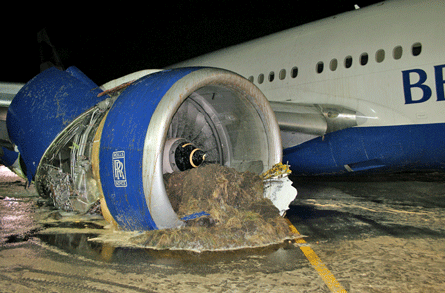Close-up photographs of the fan blades in the port (No 1) and starboard (No 2) Rolls-Royce Trent 800 engines of the British Airways Boeing 777 that crash-landed short of London Heathrow Airport's runway 27L yesterday show dramatically different damage patterns.
The considerable damage to the No 1 fan - at least one blade missing completely and most broken off about half way between root and tip - is consistent with the engine turning with at least some power on as the gear collapsed and the engine contacted the soft ground.
|
|---|
© Heathrow Pictures/PMPort (No 1) engine damage is consistent with the engine turning with at least some power on |
The No 2 engine has received damage from the ground consistent with it being stationary or windmilling with little or no power on.
Starboard (No 2) engine has received damage from the ground consistent with it being stationary or windmilling with little or no power on |
Photographs also show the ram air turbine (RAT) just behind and below the wing trailing edge on the starboard lower fuselage, but it is not certain whether this had been deployed or not. The RAT would deploy automatically on electric or hydraulic failure or can be deployed manually by the crew.
|
|---|
© Heathrow Pictures/PMIt is not certain whether the ram air turbine (RAT) - just behind and below the wing trailing edge - had been deployed |
Engine power loss appears to have been the cause the accident, in which the 777 landed just inside the airfield boundary some 500m (1,640ft) short of the runway 27L threshold. The 136 passengers were evacuated via all eight slides, with three people suffering minor injuries.
Inbound from Beijing, flight BA38 was on the approach to runway 27L when it appears the crew suffered a loss of power on both engines at some stage late in the approach.
The reason for the power loss is not yet known, but the crew managed to control the descent over the perimeter fence at Heathrow to touch down with wings level, on to grass directly on the 27L extended centreline.
The gear was down, and flap was set at about 20°, and the indications are that the crew had started the auxiliary power unit. On final approach, amateur footage shot of the aircraft shows the aircraft had adopted an uncommonly high nose-up attitude, and that the crew left gear deployment much later that would be normal procedure.
On touchdown the 777's gear dug into the soft ground, the left main gear structure eventually protruded through the top of the wing root and the right main gear separated.
The aircraft came to rest at the edge of the pre-threshold tarmac of runway 27L having made a very short ground run of about 350m. Witness reports of the aircraft attitude as it crossed the boundary fence suggest the aircraft was at or close to its stalling speed.
Sources at Heathrow say the crew had declared an emergency early on final approach but did not have time to be specific about the problem.
Almost all the passengers who have commented since the accident say the approach felt normal and the crew did not provide any warnings, but many did not realise they had "crashed" until the cabin crew ordered the evacuation. There was no fire.
Related content
Source: FlightGlobal.com



















